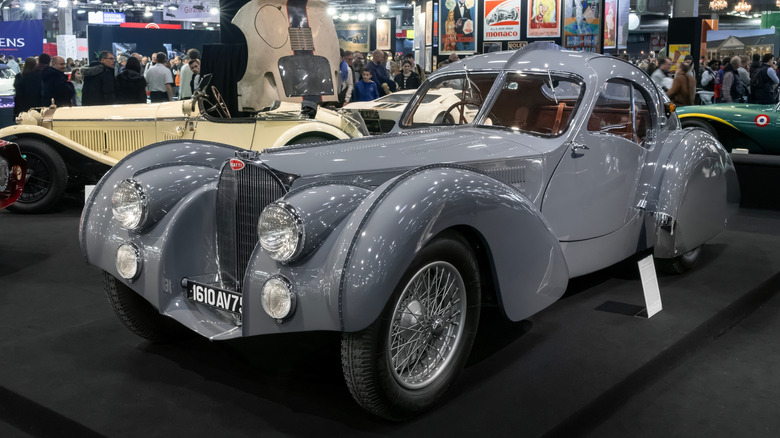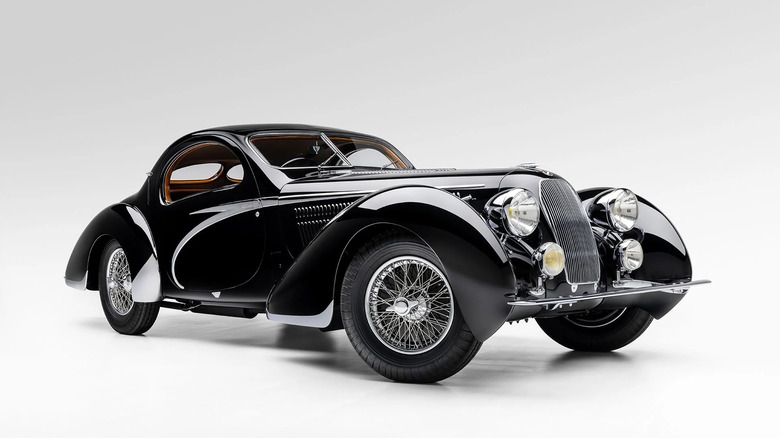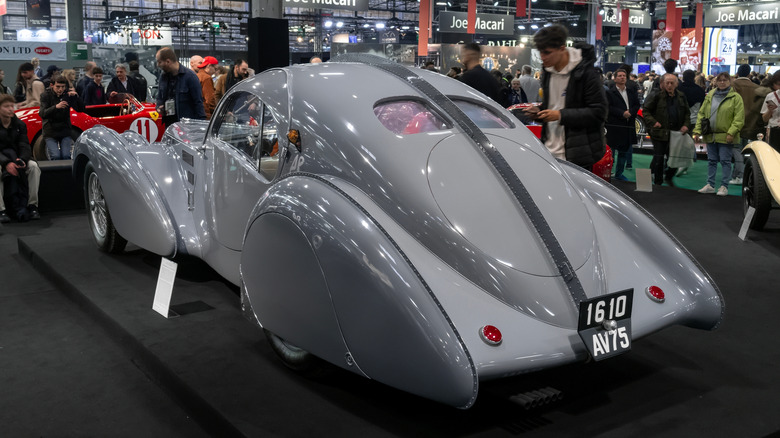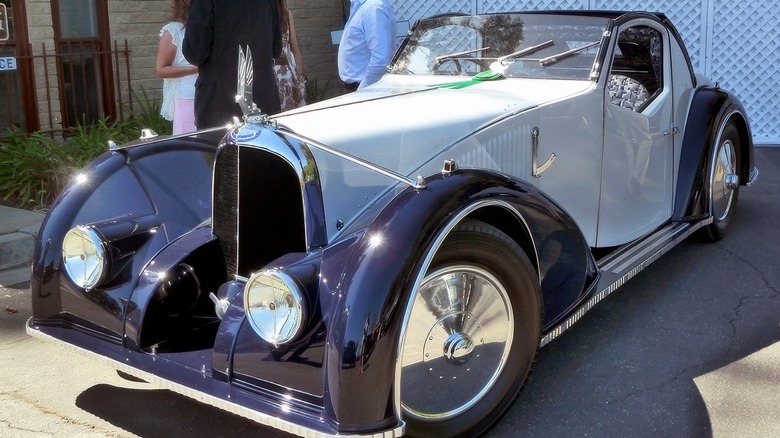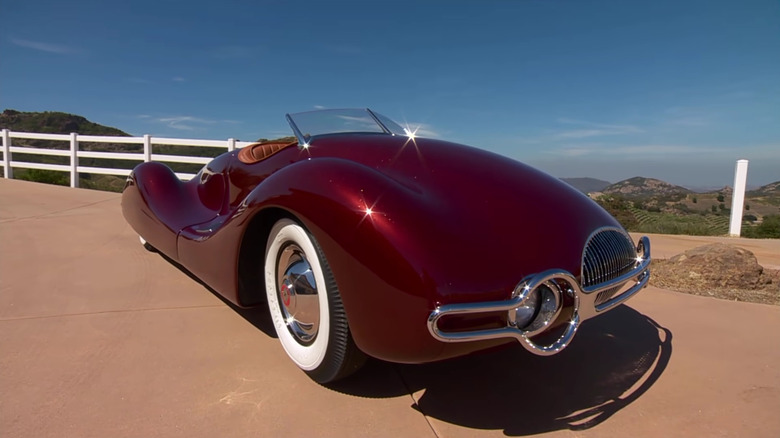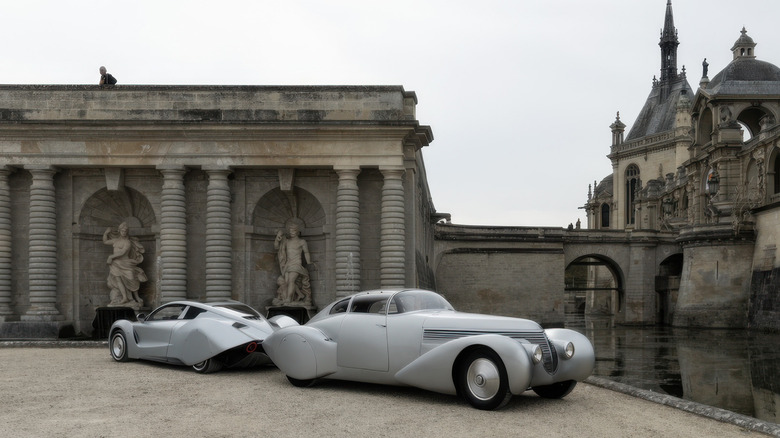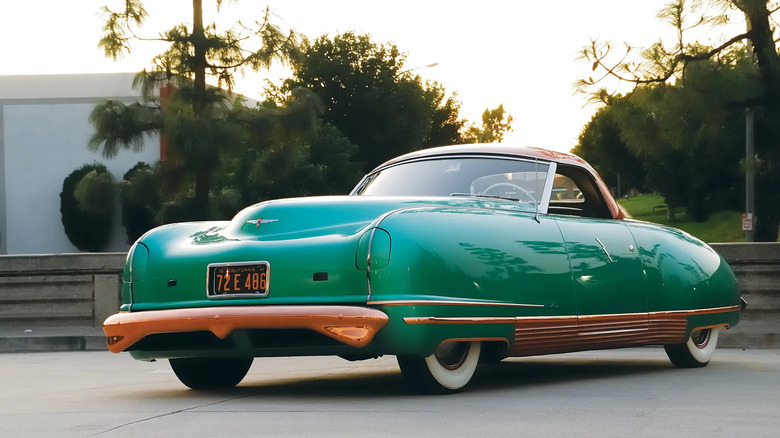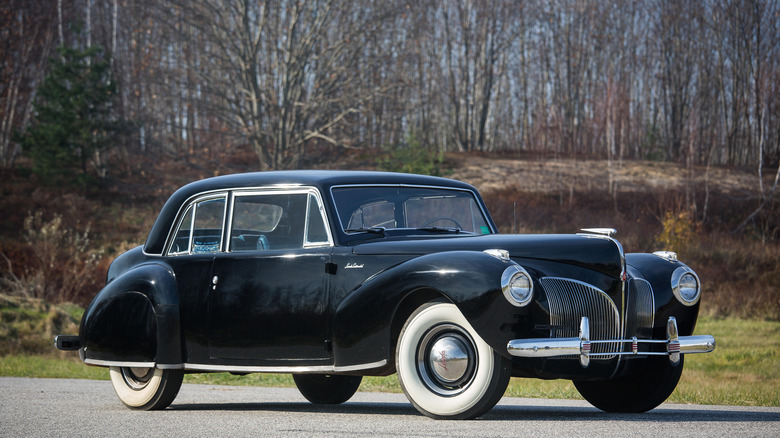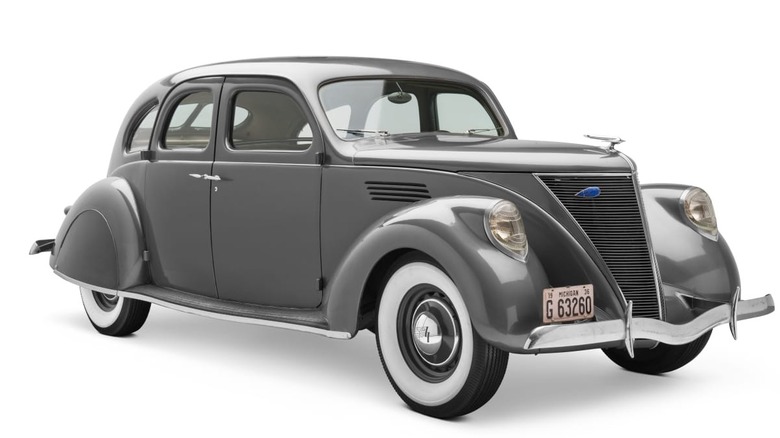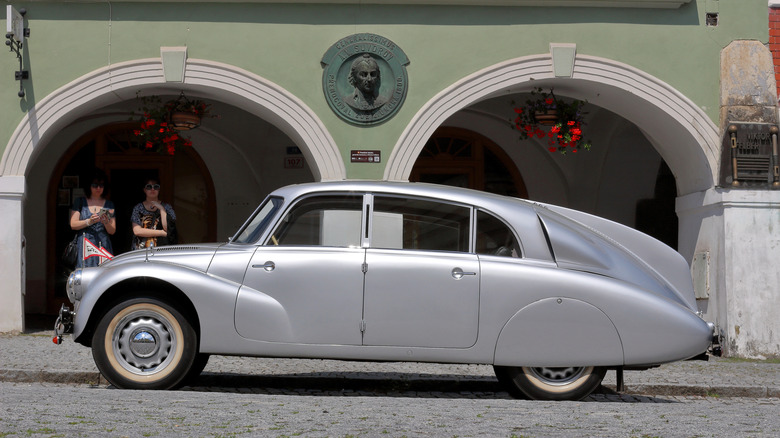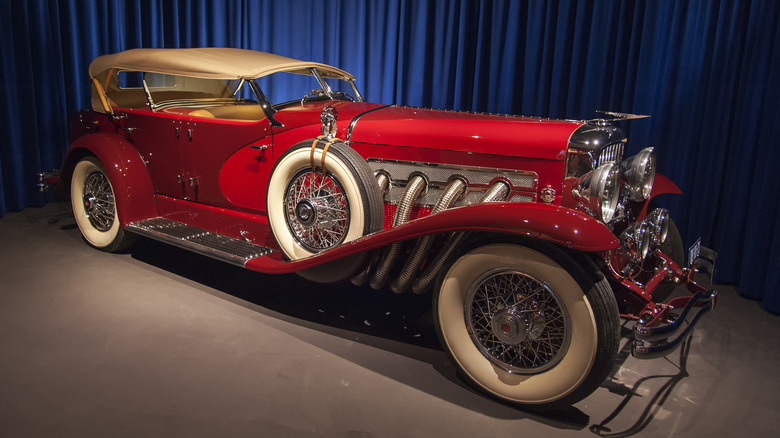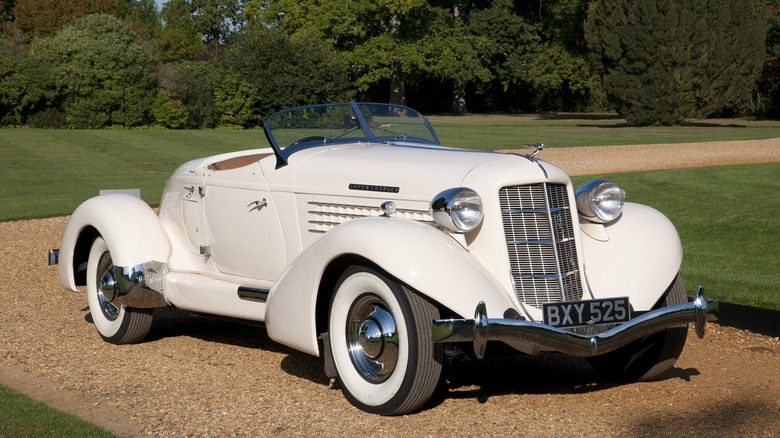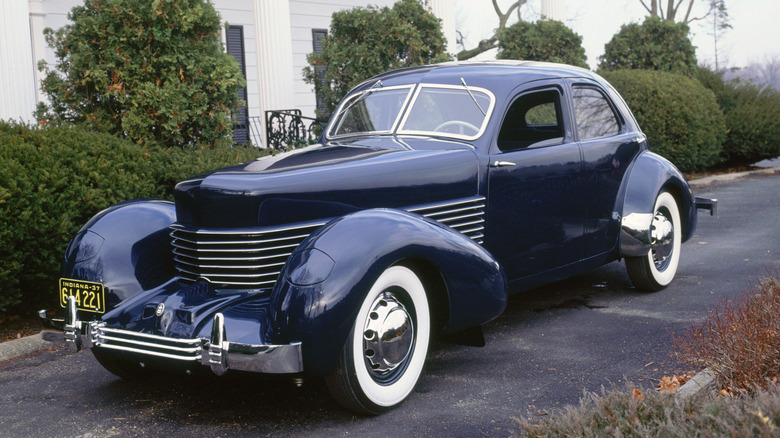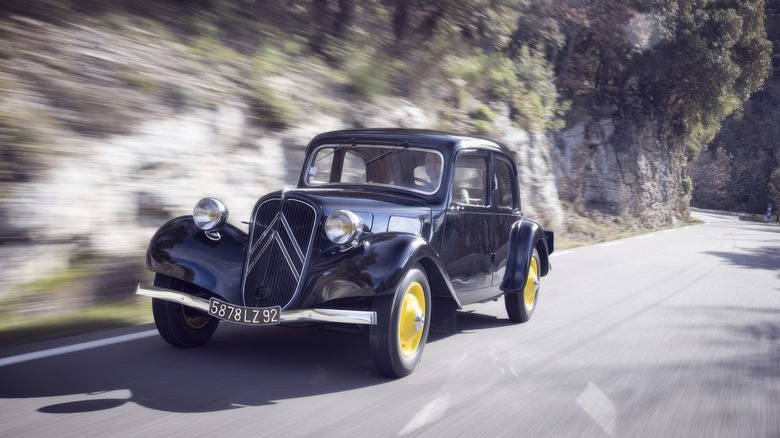13 Of The Best-Looking Art Deco Cars From The 1930s And 1940s
The automotive industry made some of the biggest leaps during the 1930s. Despite the Great Depression, automakers pushed forward with innovative solutions. Cars were faster than ever before, thanks to new engine configurations. Independent suspensions brought better handling and more comfort to the table, while synchromesh transmissions and hydraulic brakes made life easier for the driver. However, one of the biggest changes was the implementation of streamlined designs. Influenced by the Art Deco design movement, particularly the Streamline Moderne style, cars became more curvaceous than ever before. They looked fast, too, with long, graceful bodies that sat lower to the ground.
Automakers continued to push the design and technology envelope during the 1940s, despite the ongoing war. Sealed beam headlights, automatic transmission, and air-conditioning systems are only some of the innovations introduced in those years. New technologies aside, one thing is for certain — this period brought us some of the most handsome cars in history. Some of the Art Deco cars you'll see in this article remain stunning to this day, and some might even look modern. Get ready to be mesmerized by these rolling artworks.
Talbot-Lago T150 C Teardrop Coupe (1936 to 1939)
Perhaps the most stunning car to come out from the Streamline Moderne era was the Talbot-Lago T150C SS, a forgotten sports car from the 1930s that might be worth another look. The T150C SS is considered by many one of the most breathtaking cars to ever grace the road. The long-wheelbase T150C Teardrop Coupe, designed by famous coachbuilders Figoni et Falaschi, truly left a mark in automotive history. The almost liquid appearance of this stunner, accomplished by delicately sculpted hood and fenders, gave it a grace and dynamism that was atypical for the era. Meanwhile, the elegant teardrop roof and rear end accentuated the sleek, aerodynamic styling.
Figoni et Falaschi also got the details right, like the minimalistic chrome accents, the gorgeous multi-spoke wheels, and the aeronautical-like windows. Above all, it's the perfect proportions that transform the Talbot-Lago T150C into a rolling sculpture. Unsurprisingly, this feast for the eyes is predicted to sell for $6.5M-$8.5M at a Broad Arrow's Jet Center Auction. Yet, the 150C wasn't just a design exercise. It was built with racing in mind by the talented engineer Antonio Lago, and featured a lightweight design and advanced tech. The 150C SS, for instance, had independent front suspension and a 4.0-liter inline-6 with hemispherical chambers. It produced 140 hp, or 165 hp in the high-compression version, which could go over 115 mph.
Bugatti Type 57SC Atlantic (1938)
Launched two years after Talbot-Lago's historical sports car, Bugatti's Type 57 SC Atlantic Coupé is the more popular of the two machines. First shown in 1938 in its visually striking "La Voiture Noire" version, this compact vehicle showed that small sports cars can also be elegant.
Bugatti was already known for merging luxury and performance, but the Type 57 was the ultimate grand tourer, packing a potent 3.3-liter inline-8 with 200 hp and a top speed of over 125 mph. It was a technological tour de force, too, having been built with Elektron — an alloy of 90% magnesium and 10% steel. This material was ahead of its time, but it was also impossible to weld. Thus, Bugatti riveted the body parts together, creating the recognizable dorsal seam which is still used in some of Bugatti's modern vehicles.
Still, the Type 57SC Atlantic almost certainly trumps its descendants as the most expensive Bugatti ever built. Part of the reason is its rarity — only four of these cars were ever built — but being one of Bugatti's finest-looking vehicles couldn't have hurt. Its futuristic styling — with bold, aerodynamic lines, art-deco-inspired chrome accents, curved tail, and organic wheel arches — give it a timeless, almost ethereal appearance.
Voisin C27 Aérosport (1934 to 1935)
The Type 57 and T150C transcended classic automotive design, but they both need to thank the Voisin C27 Aérosport for starting the trend of low-slung, streamlined vehicles in the industry. First shown at the 1934 Paris Motor Show, this striking sports coupe was based on the quirky C25 Aérodyne, though shortened and lowered to create a sportier appearance. The C27 Aérosport incorporates the classic Streamline Moderne style, with a long hood and a teardrop rear end, sculpted in stretched proportions for a graceful, dynamic appearance. Unlike Bugatti and Talbot-Lago, though, Voisin opted for geometric patterns elsewhere: The angular windows and ornate chrome detailing bring an avant-garde look to the C27 Aérosport that looks striking to this day.
But Voisin's automobile wasn't only a rolling design marvel — it was also technologically advanced for its era. The C27 Aérosport's most notable features were the sliding roof that turned this coupe into a roadster and the adjustable hydraulic shock absorbers. Under its angular bonnet, it featured a 4.0-liter, sleeve-valve inline-6 with 110 hp, developed for smoothness rather than performance.
Norman E. Timbs Buick Streamliner (1948)
This 1948 concept car, designed by Norman E. Timbs, is an automotive art masterpiece that deserves more attention than it gets. With its organic yet futuristic shape, the Buick Streamliner looks almost like a marine creature. The low, wide grille with integrated headlights further develops the aerodynamic style, while a stunning side profile gives it an elegance few other cars can match. The Streamliner is 17.5-foot-long, too, so it must look even more graceful in person. Impressively, its body was made out of two big chunks of aluminum, meaning there is only one gap in the whole car. Fluid and seamless, the Streamliner gives an impression of movement even when it stands still.
This one-of-a-kind vehicle isn't remembered just for its gorgeous design. Norman E. Timbs was a mechanical engineer, after all, and the Streamliner's chassis layout might be even more impressive. Taking inspiration from Audi (then Auto Union) and its monstrous V16-powered race cars, Timbs positioned Buick Streamliner's inline-8 engine in the middle of the car. This vehicle was also featherlight, with a curb weight of 2,200 pounds. That, along with the slippery body, allowed the 200-hp engine to push the Streamliner to 120 mph.
Hispano-Suiza H6C Dubonnet Xenia (1938)
Today, Hispano-Suiza might be most known for the extravagant (and somewhat odd-looking) Carmen Boulogne hyper EV. But Hispano-Suiza is also a legend of the Spanish auto industry, producing some of its most luxurious cars during the Art Deco era. Perhaps the brand's most handsome machine was the H6C Dubonnet Xenia — a streamlined automobile that served as the inspiration for the modern Carmen Boulogne hypercar.
To this day, many would say that the original looks way better. Penned by André Dubonnet, an aviator, racing driver, and athlete, the Dubonnet Xenia is one of the best examples of the Streamline Moderne movement. Thanks to its teardrop-shaped wheel arches and huge grille that extends to the sides of the hood, this car looks far more extravagant than other machines of its era. The bubble roof and wraparound windshield draw clear inspiration from fighter jets, while the shark-like tail and concentric-circle wheels add to the Xenia's lavish design.
Dubonnet built this stunner over the chassis of the Hispano Suiza H6C. As a result, the Dubonnet Xenia was equipped with the brand's 8.0-liter engine. The inline-6 unit was developed starting from the brand's V12 airplane engines, and produced 160 hp. Paired with a four-speed manual transmission, the result was a luxurious grand tourer that could be pushed up to 110 mph.
Chrysler Thunderbolt (1941)
The 1941 Chrysler Thunderbolt was never made into a production car, but the prototype might've been one of the most impressive ones ever shown by the company. A perfect specimen of Art Deco streamlining, the Thunderbolt oozed futurism, with its graceful side profile and copper details. The lack of a front grille, then, evokes the look of today's EVs. The Thunderbolt was truly ahead of its time, showing that less is more in automotive design.
The Thunderbolt was a technological tour de force, too. It had pop-up headlights, despite being developed in 1941. It also featured a retractable hardtop, electro-hydraulic doors, and electric windows. The doors opened with push buttons, too, showing just how far Chrysler was willing to go to give a streamlined look to the Thunderbolt. This model was even equipped with a three-speed semi-automatic transmission with overdrive, which would only appear on automobiles after the war.
Named after Captain George Eyston's 1938 land speed record-holding car, the Thunderbolt needed an engine to match its credentials. Under that beautiful, uninterrupted bonnet, Chrysler placed a 5.3-liter inline-8 "Spitfire" engine, which produced 143 hp and allowed the Thunderbolt to reach a top speed of over 100 mph. Not quite the 369 mph of the other, record-breaking Thunderbolt, but enough to justify its name and to make it one of the most expensive Chrysler cars ever made. A mint-condition Thunderbolt was sold for $935,000 at a 2011 RM Sotheby auction; Today, it might cost even more.
Lincoln Continental (1940 to 1941)
Launched in the midst of war, the first-gen Lincoln Continental, available in both coupé and convertible body styles, might be the classiest car ever made. Clearly following the Art Deco principles — with a sharp, dignified front end, flowing lines, and streamlined side profile — the original Continental set the bar for the luxury automobile going forward. Notably, it started the "Continental look," which incorporated a huge C-pillar and notchback roofline. The placement of the spare tire on top of the trunk influenced many 1950s cars as well.
E.T. Gregorie designed the Continental on account of Edsel Ford, who seems to have been inspired by a trip to Europe. Gregorie captured the sophisticated look that Ford wanted, and it's not surprising to learn that the businessman owned a 1941 convertible model. If you feel like you've seen the Continental before, it might be thanks to its role in "The Godfather," which is widely considered to be one of the best movies of all time.
The first Continental was born when the V8 was still in its infancy. Under its boat-like bonnet, this car hides a 4.8-liter V12 engine, good for 120 hp. Paired with it was a three-speed manual transmission with overdrive, making it a capable long-distance cruiser. In 1940, the Continental started at $2,778, or around $64,000 in today's money. Surprisingly, this classic car is still somewhat affordable in the modern era; The 1941 Continental Coupé that was featured in "The Godfather" was sold for $69,000 at a 2013 Bonhams Cars auction.
Lincoln Zephyr (1936 to 1942)
The Continental might have had a more peculiar look, but it was the Zephyr that established common design practices for the brand. Elements like the V-shaped nose with a huge grille, the flowing wheel arches, the recessed windows, and the integrated, oval headlights all seem to descend from the Zephyr. The same can be said for broader design choices, like the streamlined body and the teardrop-style rear end and trunk. The Zephyr is easily one of the most striking luxury cars from the 1930s, and one of the models that help establishing Lincoln as one of the main players in the market.
Just like it did with the Continental, Lincoln equipped the Zephyr with a V12 paired to a three-speed transmission. The 4.4-liter engine produced 110 hp, enough for a top speed of 90 mph, and was updated to a 4.8-liter V12 in 1941. Unlike the Continental, the Zephyr was also available as a sedan, making it more versatile. The Zephyr isn't remembered only for its design — it was also one of the first unibody cars. This made it smoother over bumpy roads and overall lowered its weight to about 3,300 pounds. It sat lower to the ground, too, making ingress and egress easier.
Tatra T77 (1934 to 1938)
Speaking of low-slung vehicles, few did it better in the 1930s than the Tatra T77. Considered by many to be the first car designed to be aerodynamic from the ground up, the T77 had its engine in the back, behind the rear axle. This approach, later copied by the VW Beetle among others, meant there was no need for a propeller shaft to run along the body of the car, allowing Tatra to position the vehicle much lower to the ground.
However, it was its design that turned this car into an icon. Tatra famously used a wind tunnel to optimize the airflow around the body, going so far as to incorporate a fin at the back in an attempt to increase stability. The result: a drag coefficient of 0.22 CD. While efficiency was the driving factor, this approach made for a striking vehicle that looked much more futuristic than its contemporaries. Long, low-slung, and fluid; The T77 looks classy to this day.
Unlike its American rivals, though, Tatra didn't have a powerful engine at its disposal. The T77 was equipped with an air-cooled 3.0-liter V8 with hemispherical combustion chambers, which was only good for 60 hp. Still, thanks to its streamlined body, the T77 had a top speed of 87 mph, comparable to other luxury cars of its time. A 75-hp, 3.4-liter V8 was introduced in 1935, bringing the top speed to 93 mph. The T77 was not hugely successful, but Tatra continued building rear-engine, air-cooled V8 sedans until 1999.
Duesenberg Model J (1929 to 1937)
Today, Rolls-Royces are considered the kings of luxury. Back in the 1930s, though, it was the Duesenberg Motors Company that carried the crown. The automaker's top offering was the Model J — an opulent, elegant luxury car for those with very deep pockets. Sleek, yet with incredible road presence, the Model J was a perfect example of Art Deco design — minus the streamlining part. The shiny, chrome bits certainly catch the eye, giving the car an almost jewel-like appearance.
But Duesenberg wasn't the king of the industry only because its cars looked sophisticated — it was also a highly innovative brand. The Model J was the first car with hydraulic brakes and a featured a straight-8 engine. Speaking of the beast, the 7.0-liter unit generated an astonishing 265 hp, thanks to the highly advanced DOHC configuration with four valves per cylinder.
A supercharged version of this vehicle, introduced in 1932, increased the output to 320 hp. The new Model J could accelerate from zero to 60 mph in eight seconds, reaching a top speed of 129 mph. In a 1930s luxury car, these figures are just bonkers. Duesenberg even used vibration dampers filled with mercury to maximize refinement.
Auburn 851/852 Speedster (1935 to 1936)
The Auburn Automobile Company is another brand that no longer exists, which is a shame because it made some of the coolest-looking cars of its time. The company's crown achievement was probably the 851/852 Speedster. This classy sports car boosts an incredibly graceful design and powerful road presence, making it one of the most handsome cars from its era. Its streamlined, sculptural shape clearly follows the Art Deco rule book, but the perfect, stretched-out proportions give it a timeless look that still resonates to this day.
The 851 Speedster (which became the 852 Speedster in 1936) performed as well as it looked. Auburn opted for a 4.8-liter Lycoming straight-8 engine. In base form, it produced 115 hp, but a supercharger version bumped the output to 150 hp. This model had a top speed of 102.5 mph — quite a lot for a 1930s open-top sports car. Unfortunately, the 851/852 Speedsters were the last models made by Auburn. In 1937, owner Errett Lobban Cord sold his holdings in the Cord Corporation, which forced the Auburn brand to cease production.
Cord 810/812 (1936 to 1937)
The Cord 810/812 was one of the most advanced automobiles in its era, incorporating many hi-tech features we take for granted today. Those include variable speed windshield wipers, a built-in radio, a disappearing convertible top, and front-wheel drive. The latter was quite significant for its era, enabling Cord to cut the propeller shaft and bring the car closer to the ground. Its predecessor, the L-29, was actually the first ever FWD car.
Front-wheel drive doesn't always mean poor performances — the 810/812 packed a 4.7-liter V8, good for 125 hp in regular and 170 hp in supercharged form. Both versions were paired with an advanced four-speed transmission with a Bendix Electric Hand shifter. The 810/812 was known as "baby Duesenberg", and it certainly deserved the moniker; It was certainly better than the car's other popular nickname of "coffin nose".
The 810/812 was one of the coolest cars on sale during the 1930s. The "coffin nose", with its low, wide grille, gave it undeniable road presence, with the streamlined design body providing a sophisticated look. The 810/812 even had concealed headlights, cranking that Streamline Moderne look to eleven.
Citroën Traction Avant (1934 to 1957)
Over the pond, French automaker Citroën was putting everyone on notice with the Traction Avant. This might have been the single most innovative vehicle of its era, with a groundbreaking monocoque structure and front-wheel-drive architecture that allowed Citroën to lower the vehicle's height significantly, giving it a noticeably low stance for the 1930s. The streamlined wheel arches, long bonnet, and sloping side windows further accentuate the elegance of this car.
Pleasant looks aside, the Traction Avant outclassed its rivals in many other fields. It had independent front and rear suspensions, hydraulic brakes, and, starting in 1936, rack and pinion steering. With the 1954 Traction Avant 15 Six H, then, came the hydropneumatic suspensions, an innovative technology developed by Citroën that was ahead of its time.
Perhaps the only area where the Traction Avant lagged behind its American rivals was its engine. The most powerful unit offered by the brand was a 100 hp, 3.8-liter V8, while the base engine was a 1.9-liter four-cylinder. However, the monocoque structure had made the Traction Avant incredibly lightweight. Even 100 hp were enough to reach a top speed of 87 mph when the weight was as low as 2,500 pounds, while providing the vehicle with agility and comfort that surpassed its contemporaries.
